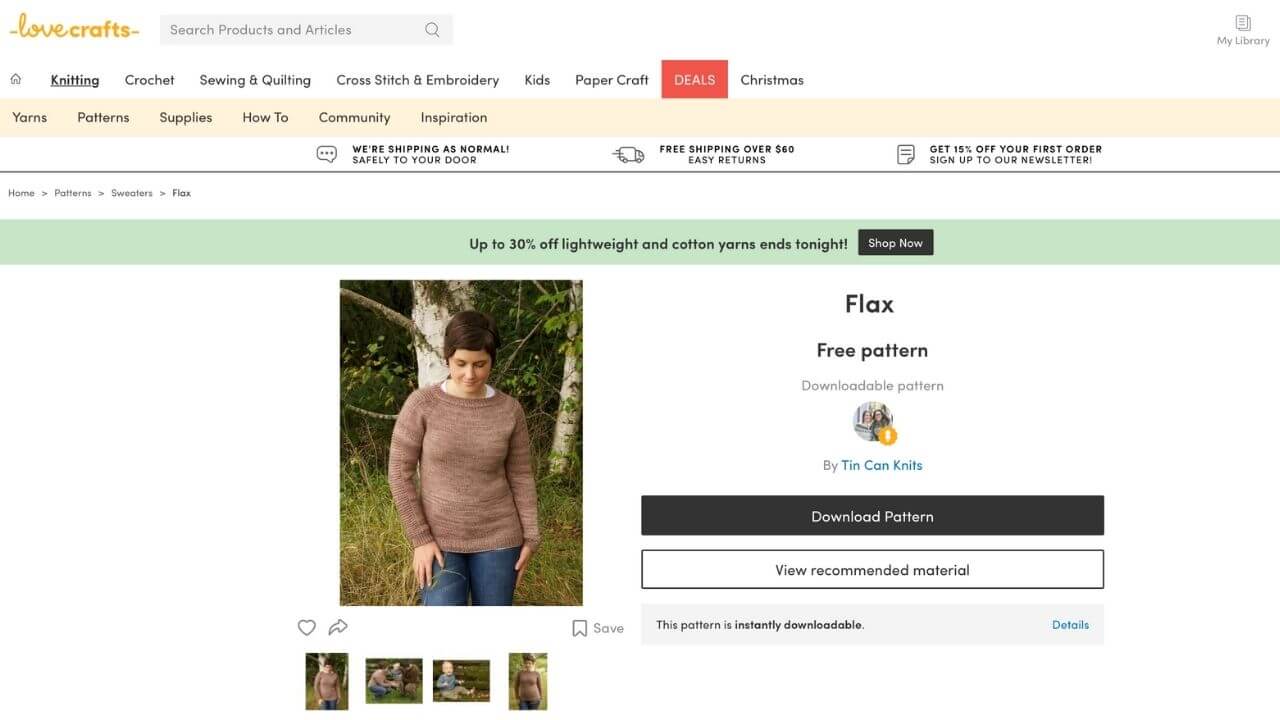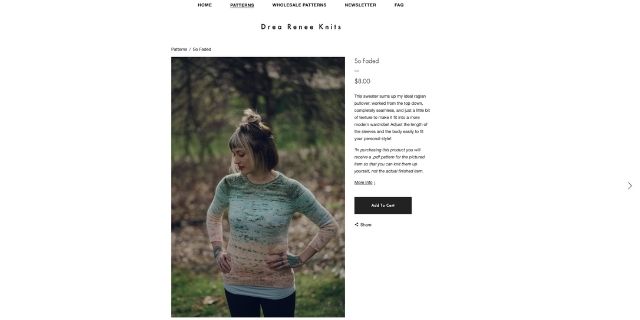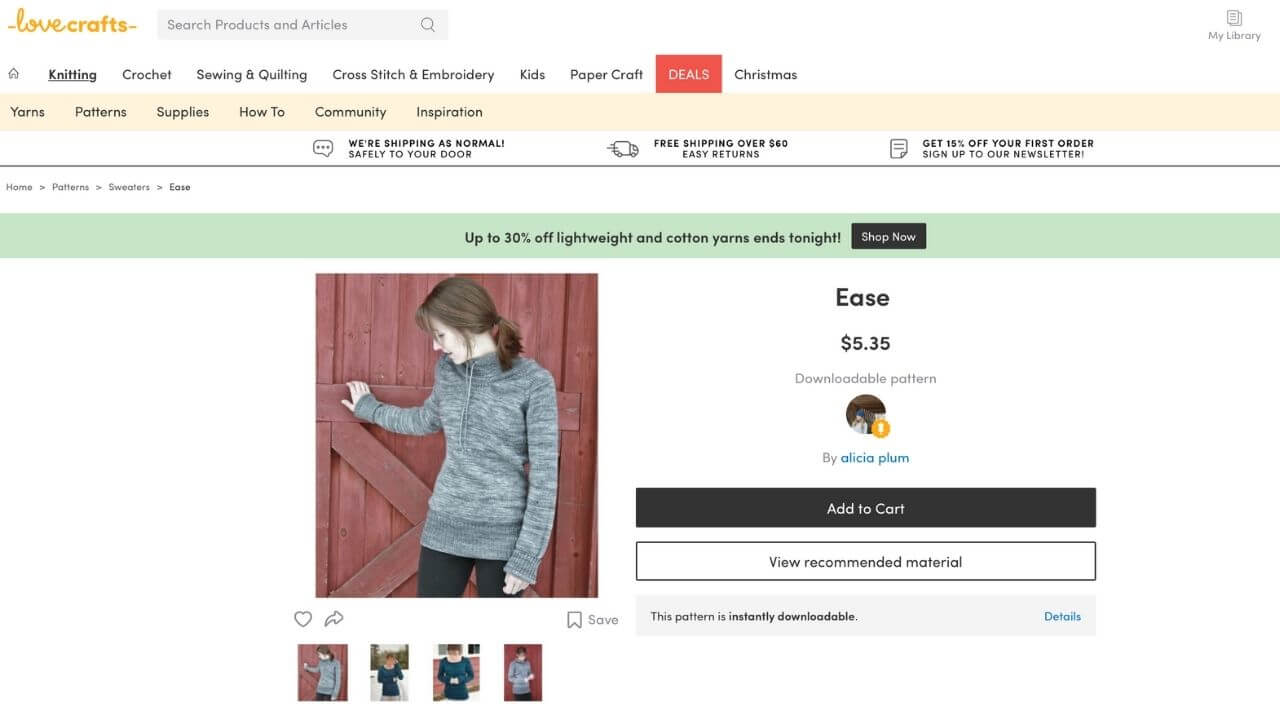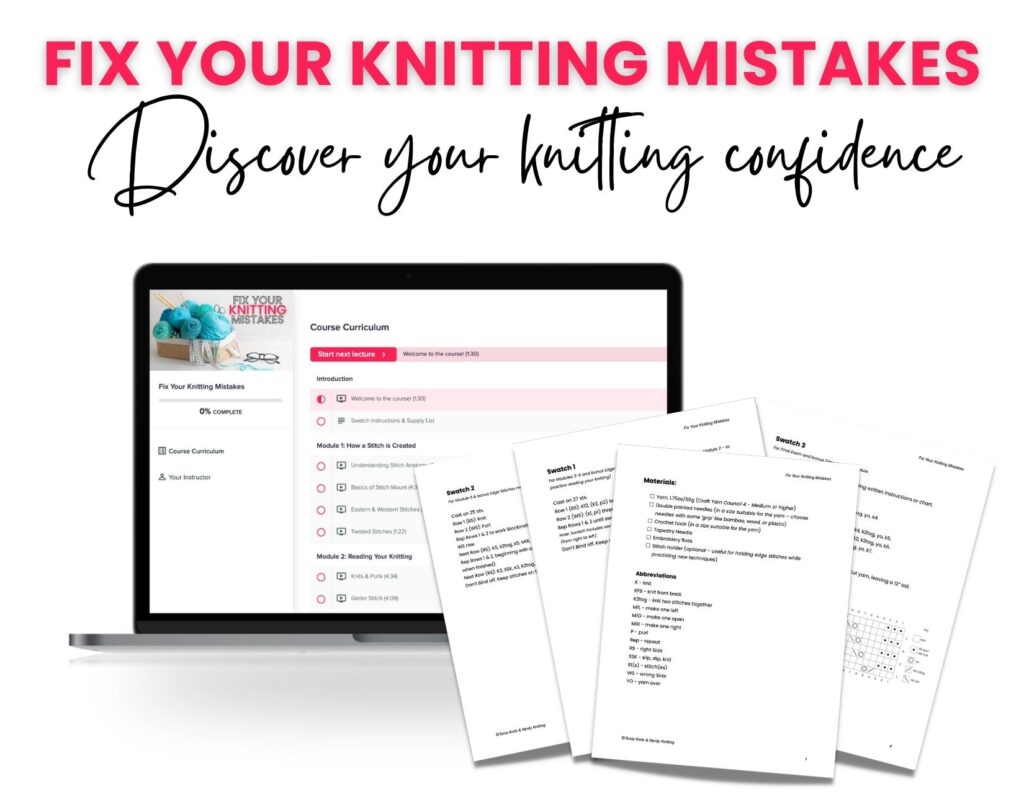Knitting a sweater is a right of passage for every knitter. For beginner knitters, I recommend a top-down raglan sweater that’s worked in the round. It’s a simple construction that can be tried on as you knit to ensure a good fit. Here are eight simple sweater patterns that are perfect for beginner knitters.
Here are the sweater patterns I recommend for new knitters:
- Flax from Tin Can Knits
- Learn to Knit a Woman’s Sweater by Stacy Perry
- So Faced by Andrea Mowry
- After the Rain by Heidi Kirrmaier
- Ease by Alicia Plummer
- Beginner Raglan from Knitatude
- Apogean from Olive Knits
- Adelaide Pullover from Quince and Co.
All of these patterns share a similar construction – casting on at the neckline and joining in the round. Increases are spaced to add width for the body and for the sleeves before the sleeves are put on hold while the body of the sweater is worked. When that is complete, the sleeves are picked up and finished as well.
Let’s take a closer look at each of these eight sweater patterns (I’ve also included some recommended yarn).
The links below include affiliate links. If you click through and make a purchase I may receive a small commission at no extra cost to you. See the disclosure policy for more information.
Flax
Tin Can Knits iconic sweater, Flax, is a popular pattern for a reason – it’s well-written and has clear instructions making it easy to follow. It features a crew neck and a Garter stitch detail on the sleeves for a bit of textural interest. Worked in a worsted weight yarn, it’s a fairly quick knitting project.
Get the pattern: Flax
Get the yarn: Cascade 220 Superwash

Learn to Knit a Woman’s Sweater
If a full video tutorial is something that interests you, Staci Perry’s sweater pattern is the choice for you. She carefully walks you through each step of the process with her YouTube video. The simple design uses yarn overs for the increases so the raglan design has a decorative touch. It’s worked in a cotton, sport weight yarn for a light, summer top.
Get the pattern: Learn to Knit a Woman’s Sweater
Get the pattern: Knit Picks Shine Sport
So Faded
Fading is a popular technique that involves using a few skeins of various contrasting colors and alternating rows between the skeins to slowly fade from one color to another. This process works especially well with hand-dyed yarns and Andrea Mowry uses the technique in her So Faded sweater. Along with the faded color technique, it features a bit of texture at the shoulders for a little interest.
Get the pattern: So Faded
Get the yarn: Koigu Painters Palette Premium Merino

After the Rain
After the Rain from Heidi Kirrmaier begins by working back and forth to shape the neck (which will make the neck fit better than sweaters that omit this step) and also features picking up stitches along the neckline to finish the edge after the sweater is finished. The pattern is a simple 6-row stripe repeat and also includes optional waist shaping. There’s lots of good stuff packed into this pattern.
Get the pattern: After the Rain
Get the yarn: King Cole Bamboo Cotton DK
Ease
Ease is the sweater for those who like the pullover, hoodie style. It’s worked in a worsted weight yarn and, while there is some positive ease built into the pattern, it features a bit of waist shaping for a more tailored fit. There are two options for the necklines – a classic scoop neck or the drawstring collar (if you opt for the drawstring collar you’ll need an additional 200 yards of yarn).
Get the pattern: Ease
Get the yarn: Malabrigo Rios

Discover the Confidence You Need to Fix Your Knitting Mistakes

By the end of this six-part self-paced course, you’ll be able to read your knitting, recognize a variety of knitting mistakes, and understand how to fix them.
Beginner Raglan
This cute pattern is perfect for beginners. It’s worked in a bulky yarn so it will knit up very quickly and it will be easy to see exactly what you’re doing (and picking up dropped stitches in bulky yarn is very easy). The design is simple with a basic K1P1 rib for the collar, cuffs, and hem and a Garter stitch body for some texture.
Get the pattern: Beginner Raglan
Get the yarn: Plymouth Yarn Encore Mega
Apogean
If you prefer V-neck sweaters, this raglan sweater is for you. Along with the V-neck, there are two options for sleeve lengths included in the pattern. The sweater also features a striped pattern and, when worked in the muted colors as in the sample, it looks wonderfully relaxed and comfortable.
Get the pattern: Apogean
Get the yarn: Cascade Heritage
Adelaide Pullover
If you’re ready to tackle a bit of lace, the Adelaide Pullover features a pretty lace panel down the front. It also has a simple rib pattern for the cuffs, collar, and hem. This pullover is worked in Quince & Co. Kestrel, a heavy worsted linen yarn with an interesting ribbon structure so it would make a beautiful summer top.
Get the pattern: Adelaide Pullover
Get the yarn: Quince & Co Kestrel

Basic Construction of a Top-Down Raglan
A top-down raglan sweater is a great first sweater pattern. Since it’s worked from the neckline down, it’s easy to try it on as you knit to make sure it’s fitting properly. And the circular construction keeps the right side of the work facing you at all times so you’ll quickly catch any mistakes. By carefully placing markers for the sleeves and body you’ll be able to keep track of all the increases needed to create the basic shape. The length of the body and sleeves are also easy to customize since they are worked from the top down.
Raglan sweaters that are worked in the round from the collar to the hem are all worked in a similar manner. First, you cast on stitches for the collar. At this point, you can work back and forth in rows to shape the neck (using short rows) or create a V-neck or scoop neck shape. Once the neckline is shaped you would join in the round. If you are skipping those steps you can go from casting on directly to joining the round. You can begin with a rib pattern or a bit of reverse Stockinette or Garter stitch for the collar (and use the same pattern for the hem and cuffs).
When the collar is complete, markers are placed at set intervals to separate the front, back, and two sleeves (see the image below). Increase stitches are worked at these points to build out the body and sleeves of the sweater. There are many ways to work these increases and add decorative elements at these points in the sweater.

When the sleeves and body are increased to their full width, the sleeves are put on holders, a few extra stitches are cast on underneath the arms and the body of the sweater is worked in the round until it’s as long as you want, then you work the hem in a rib or other pattern and bind off.
When the body is finished, each sleeve is placed back on the needles, a few stitches are picked up at the underarm to join the body and sleeves at that point. Then the sleeves are worked to the desired length before finishing with some ribbing or other pattern.
Once you weave in the ends and, if needed, pick up and finish the collar if you worked a V-neck or other neckline, your sweater is complete!
More Tips for Sweater Knitting
Here are a few more questions (and the answers!) that are often asked when it comes to knitting raglan sweaters.
What is a raglan sweater?
A raglan sweater is defined by the way the sleeves meet the body of the sweater – in a slanted diagonal line from the armpit to the neckline (like a classic baseball tee). It’s named for FitzRoy James Henry Somerset, 1st Baron Raglan who wanted a fit that allowed for a better range of motion during battle.
What is the difference between dolman and raglan sleeves?
Raglan sleeves are worked as separate pieces and joined to the body of the garment. Dolman sleeves are integrated directly into the front and back of the garment instead of being worked as separate pieces.
Is knitting a sweater hard?
Knitting a sweater is not hard. As long as you know how to cast on, knit, purl, work a basic increase and decrease, and bind off, you can knit a sweater.
More Beginner Knitting Projects
- 10 Easy Absolute Beginner Knitting Patterns
- 8 Simple Fingerless Mitt Patterns for Beginner Knitters
- 12 Beginner Shawl Knitting Patterns
